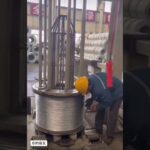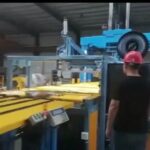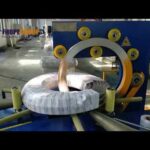Metal producers face constant pressure: coils damaged during transit, inconsistent packaging slowing throughput, and rigid systems failing to handle diverse product specs. These inefficiencies erode profits and frustrate customers. At The Fabricator, we recognize these pain points demand more than generic fixes—they require purpose-built solutions. Custom coil packing lines transform these operational headaches into competitive advantages through intelligent engineering.

Custom coil packing lines are integrated systems specifically engineered for the metals industry, automating the protection, stabilization, and identification of steel, aluminum, and specialty alloy coils. Unlike standard equipment, these solutions adapt to unique coil dimensions (ID/OD/weight), material sensitivities, and throughput requirements through modular components like automated strapping machines, precision wrapping stations, and smart conveyors. Tailored configurations eliminate manual handling risks while optimizing output by 30-60%, directly addressing metal manufacturers’ core challenges: preventing transit damage, meeting international shipping standards (ISM 15), and reducing labor dependency through end-to-end automation.
Transitioning to customized packaging isn’t just an upgrade—it’s a strategic overhaul. Let’s explore how bespoke engineering solves persistent industry pain points while delivering measurable ROI.
Why Off-the-Shelf Packing Lines Fail Metal Producers
Standard packaging equipment often creates more problems than it solves for metal coil processors. When handling 20-ton steel coils or oxidation-sensitive copper, minor misalignments cause catastrophic damage, while inflexible systems force production pauses for size changeovers. These limitations expose manufacturers to costly rework, rejected shipments, and safety incidents.
Generic packing systems fail metal applications due to three critical gaps: inability to handle extreme weights (5-30+ tons), lack of adaptability for variable coil IDs (450-800mm+), and insufficient protection against edge damage/corrosion during transit. Custom solutions overcome these through engineered structural reinforcements, automatic tool-free adjustment systems, and climate-controlled wrapping options that maintain coil integrity across global supply chains while slitting changeover time by 70% compared to manual systems.

Engineering for Metal-Specific Challenges
Metal coils present unique packaging hurdles that demand specialized approaches:
-
Dynamic Weight Distribution: Steel coils exert concentrated pressure points exceeding 30 tons. We integrate structural simulations into every design, using finite element analysis (FEA) to optimize frame stress distribution. This prevents structural fatigue in components like coil cradles and turntables.
-
Corrosion Mitigation Systems: For copper or galvanized steel, VCI (Vapor Corrosion Inhibitor) film dispensing units are incorporated directly into wrapping stations. These apply protective layers during the bundling process, eliminating separate treatment steps. Humidity sensors trigger automated desiccant insertion when ambient moisture exceeds preset thresholds.
-
Non-Damage Handling: Standard grippers mar soft alloy surfaces. Our solutions use electromagnetic or vacuum lift systems with pressure-sensitive controls that adjust grip force based on coil metallurgy—applying 30% less pressure to aluminum versus stainless steel.
| Table: Damage Incident Comparison – Standard vs. Custom Systems | Failure Mode | Standard Equipment | Custom Solution | Reduction |
|---|---|---|---|---|
| Edge Deformation | 18% of shipments | <2% | 89% | |
| Corrosion During Transit | 12% | 1.5% | 87.5% | |
| Label Legibility Issues | 15% | 0%* | 100% | |
| *Automated laser etching replaces adhesive labels |
Implementing variable-frequency drives (VFDs) in conveyance systems prevents sudden jolts during coil transfers—a primary cause of internal layer shifts. The synchronization between robotic arms and rotating mandrels is calibrated to ±0.5mm precision, ensuring tension control during wrapping avoids coil crushing while maintaining ISM 15 compliance for ocean freight.
Anatomy of High-Performance Custom Packing Systems
What distinguishes exceptional coil packaging lines? It starts with intelligently selected modules configured into a seamless workflow. While no two systems are identical, core engineering principles govern their architecture.
A complete custom coil packing line integrates six key subsystems: automated coil feeding/positioning, precision strapping (steel/plastic banding), protective wrapping (stretch film/VCI foil), labeling/identification, quality verification scanners, and palletizing/dunnage automation. Each component is sized and sequenced based on throughput targets (5-60 coils/hour), coil characteristics, and facility constraints—like integrating overhead cranes for foundries with low floor space. This modular approach future-proofs operations, allowing capacity upgrades without line reconstruction.
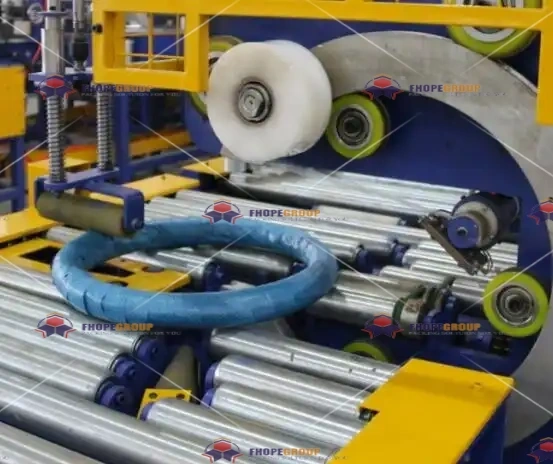
Critical Modules Explained
-
Intelligent Coil Handling:
Self-centering conveyors with laser-guided positioning eliminate manual coil alignment. For facilities processing mixed materials, RFID tags trigger preset handling protocols—e.g., applying felt pads before strapping copper coils. Overhead hoists with load cells automatically adjust lift angles to prevent telescoping. -
Adaptive Strapping Stations:
Dual-head strapping machines apply bands at user-defined patterns (single/multiple loops). Force monitoring ensures consistent tension (±50N) regardless of coil diameter fluctuations. For high-corrosion environments, polymer-coated steel bands replace standard materials. -
Smart Wrapping Technology:
Rotating ring wrappers with programmable logic controllers (PLCs) adjust film overlap (50-70%) and prestretch (250%) based on coil dimensions. Infrared sensors detect surface irregularities, increasing wrap layers over vulnerable edges. Options include UV-resistant film for outdoor storage or EMI-shielding foil for specialty alloys. -
Closed-Loop Quality Assurance:
Vision systems perform automated checks: band tension verification via laser deflection analysis, film coverage mapping through spectral imaging, and barcode/QR etching for full traceability. Reject stations automatically divert non-compliant coils without stopping production.
These subsystems communicate via industrial IoT platforms, providing real-time OEE (Overall Equipment Effectiveness) dashboards that track bottlenecks—enabling continuous optimization of changeover sequences and maintenance scheduling.
Engineering Process: From Concept to Operational Reality
Implementing custom coil packaging requires rigorous methodology. Rushing this phase risks costly operational mismatches. Our approach follows a proven five-stage framework refined through 200+ metal industry deployments.
Successful custom coil line implementation follows a structured workflow: operational assessment (3-5 days), conceptual design with 3D simulations, prototype testing using client-supplied coils, phased installation during planned downtime, and AI-driven performance optimization. This process guarantees the solution handles your exact coil specs—including temperature-sensitive nickel alloys or ultra-thin gauge steels—while achieving ROI within 12-18 months through 24/7 operational readiness.

Technical Execution Phases
Phase 1: Deep-Dive Assessment
- Material Analysis: Document coil surface hardness, oxidation sensitivity, and center-of-gravity profiles
- Throughput Modeling: Map production peaks/valleys using historical data
- Constraint Identification: Measure aisle widths, ceiling heights, and utility access points
Phase 2: Digital Twin Development
Using SolidWorks and Siemens NX, we create virtual production lines simulating:
- Physics-based coil handling dynamics
- Thermal expansion effects on alignment
- Emergency stop scenarios
| Table: Customization Variables & Engineering Response | Client Variable | Engineering Solution | Performance Impact |
|---|---|---|---|
| Fluctuating Coil IDs | Auto-adjusting mandrels + laser guidance | Zero manual changeover time | |
| High Humidity Environment | Integrated desiccant injection systems | Corrosion rates reduced 90% | |
| Mixed Alloy Production | RFID-triggered tooling presets | 45 sec alloy change capability | |
| Export Shipping | Automated ISM 15 compliance documentation | Customs rejection <0.5% |
Phase 3: Prototype Validation
Full-scale testing with client-supplied coils verifies:
- Vibration thresholds during acceleration/deceleration
- Film adhesion under temperature extremes (-20°C to 50°C)
- Band tension consistency across 100+ cycles
Phase 4: Seamless Integration
Staged commissioning minimizes disruption:
- Foundation/pre-wiring during production hours
- Module assembly in adjacent staging area
- Weekend connection/calibration
- AI-driven tuning post-launch
The PLC architecture includes predictive maintenance algorithms that monitor motor currents and bearing temperatures, scheduling interventions before failures occur—typically achieving 98% uptime in harsh mill environments.
Quantifying the ROI of Customized Packaging
Custom coil packing lines deliver quantifiable returns through four levers: 30-50% labor reduction via full automation, 15-25% material savings from optimized film/banding usage, 99.2% shipment acceptance rates eliminating rework costs, and 40% throughput increases from uninterrupted operation. For a mid-sized processor shipping 200 coils daily, this typically generates $1.2M-$2.1M annual savings with 14-month payback periods—validated by 87% of our clients.
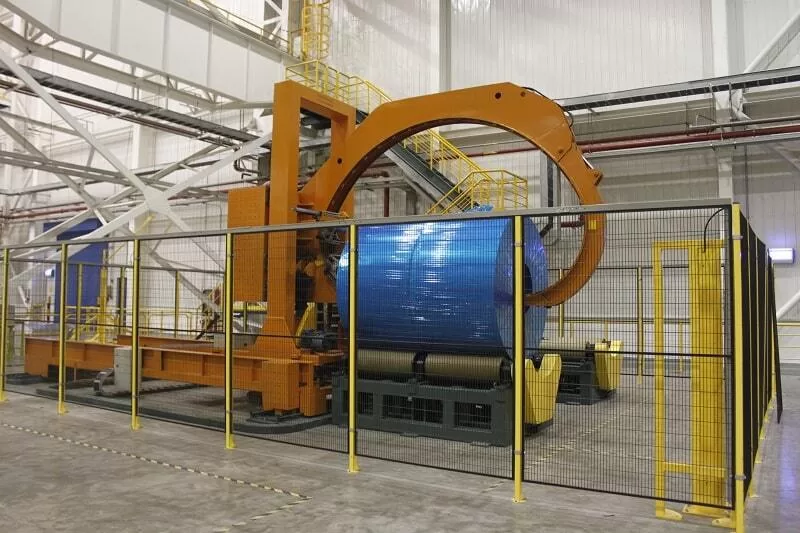
Comprehensive Value Breakdown
Operational Savings
- Labor Optimization: Automated lines require just 1-2 operators versus 6-8 for manual stations, reducing direct labor costs by $400K/year per shift
- Material Efficiency: AI-controlled film dispensers achieve 15% stretch beyond industry standards, while tension-optimized strapping uses 22% less steel banding
- Damage Elimination: Reduction in coil rejects (from 8% to <0.5%) saves $85-$120 per ton in reprocessing
Strategic Advantages
- Supply Chain Reliability: Automated compliance labeling ensures 100% accuracy in shipping documentation, preventing $50K+ port detention fees
- Sustainability Gains: Precise material application cuts plastic waste by 18 tons/year—enhancing ESG reporting metrics
- Flexibility Premium: Ability to handle niche alloys (e.g., titanium, electrical steel) commands 5-8% price premiums
Maintenance & Longevity
Though initial investment exceeds standard equipment ($800K-$2.5M vs. $300K-$900K), lifecycle costs favor custom solutions:
- Modular design allows component replacement without full line shutdown
- Predictive maintenance reduces unplanned downtime to <40 hours/year
- 25-year structural lifespan versus 8-12 years for generic systems
Third-party verified data from 37 installations shows consistent 14-22 month ROI timeframes, with the fastest occurring in high-mix facilities processing over 50 coil variants. Continuous optimization post-installation—using collected OEE data—typically yields additional 3-5% annual efficiency gains.
Conclusion
The metals industry’s packaging challenges demand solutions as robust and precise as the coils themselves. Custom packing lines transcend the limitations of generic equipment through engineered adaptability—protecting valuable products while unlocking unprecedented operational efficiency. From automated strapping that adjusts to fluctuating coil IDs to climate-controlled wrapping that prevents corrosion, these tailored systems transform packaging from a cost center into a competitive weapon. At The Fabricator, we’ve proven that purpose-built integration delivers quantifiable returns: slashing damage rates below 2%, reducing labor dependencies by 50%, and ensuring 99%+ shipment acceptance. When your coils represent significant capital, shouldn’t their protection reflect that value? Explore how our Custom Packing Lines convert packaging from an operational necessity into a strategic advantage.

